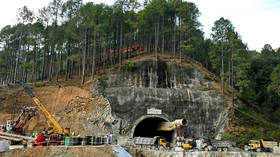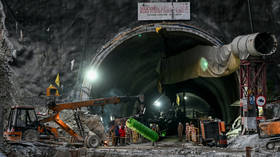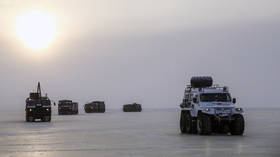Rescue mission to save Indians trapped in tunnel enters third week

A new strategy has been adopted by rescue teams in India, who have been working tirelessly since November 12 to free 41 people trapped inside a collapsed tunnel which had been under construction.
On Sunday, emergency services began drilling vertically from above to reach the trapped men 86 meters beneath. Swift progress has reportedly been made so far; having already drilled through 30 meters of rock, ANI news agency reported on Monday, citing officials.
Rescue operations have hit several snags due to the difficulty of the Himalayan terrain and the failure of several pieces of equipment. A machine used to drill a hole through the tunnel became stuck several times when its blades became mired in debris. A plasma cutter machine was ordered from southern India’s Telangana state to remove the broken parts. The rest of the rescue operation has been carried out using manual drilling, officials said.
Earlier, senior National Disaster Management Authority (NDMA) member Lt General Syed Ata Hasnain (Retd.) compared the mission to a “war.” “When you do something with mountains, you cannot predict anything” he was quoted as saying by the Times of India. Tunneling expert Arnold Dix, who had flown in from Australia to be part of the mission, has largely advocated a “safety first” approach and warned against “rushing” the rescue.
The workers were building the tunnel when part of it caved in on November 12, due to a landslide. Contact was established in the first days of the rescue mission, and oxygen, medicine and food has been provided to the men through steel pipes. A National Disaster Management Authority official on Sunday said the men were “in good health.”
The trapped workers had come from all parts of the country to be part of the tunnel project. Fifteen were from the Jharkhand state, eight from Uttar Pradesh, five each from Odisha and Bihar, three from West Bengal, two each from Uttarakhand and Assam, and one from Himachal Pradesh.
A panel of experts investigating the disaster has said the tunnel did not have an emergency exit and may have been built through a geological fault known as a "shear zone", which could have caused the collapse, Reuters reported on Friday, citing an unnamed source.
The tunnel is a part of the ambitious, $1.5 billion Char Dham project, designed to connect four important Hindu pilgrimage sites in northern India via a 890 km, two-lane road. It was being built by the state-run National Highways and Infrastructure Development Corporation, under the aegis of India's transport ministry.
Where India Meets Russia – We are now on WhatsApp! Follow and share RT India in English and in Hindi














